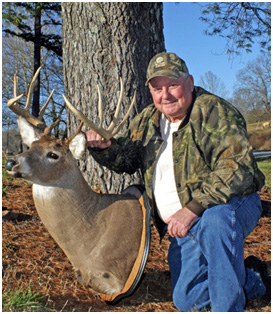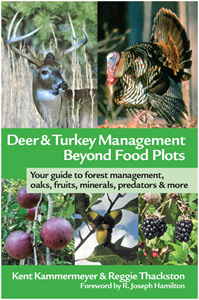 |
By: Kent Kammermeyer - Certified Wildlife Biologist/Consultant |
Plant Early for Attractive Rutting Season Plots
... Fall Planting season is nowWhen the fall rut gets into full swing in November and December, you need to be ready to anchor those does when they come into heat and start driving those big bucks crazy! There is no better way to do this than planting a high quality food plot 1) that is still green and often still growing in cold weather, and 2) has stockpiled tons of forage either above or below ground for cold weather use (Brassicas). These forage need to be planted in August (North) or September (South) because they need time to develop a strong root system and top growth before the cold weather of December. There are a few food plot plants that do a better job of providing high quality forage than all the rest when the combination of cold and rut arrives. Even some well- known cool season food plot plants mostly shut down their growth after November. When they do this, protein levels in leafy forage declines and plots become less attractive to deer. The one exception is the Brassica family when cold and freezes serve to raise sugar (carbohydrate) levels in plant leaves making them very attractive to deer.
Four general categories of plants do the best job of hanging in there in the cold when others quit. These are winter peas, Brassicas, some small grains and some clovers. Read the profiles below, but do not settle on one species or plant yet, you will need at least two mixtures or combinations for your rut plots because they shut down in sequence not all at once. Some mixtures are suggested in the profiles, but the best ones are summarized at the end of the article, after the profiles.
Austrian Winter Pea species profileAustrian winter pea may be the ultimate cool season ice cream plant for deer, ranking very high on preference lists. It is an annual legume with very good nitrogen fixing capabilities. Austrian winter pea is a low-growing, viney legume, which can fix over 200 lbs./acre/year of nitrogen under good conditions.
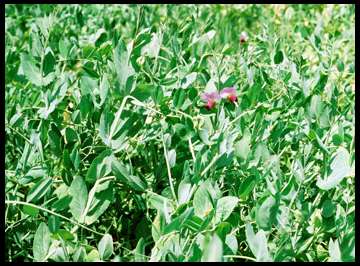
Normal planting dates in are August and September (moving north to south). The pea is somewhat slow staring and quite vulnerable to overgrazing. Broadcast plant at 30-40 lbs/acre and cover one-half to one inch deep. Be sure to inoculate with bacteria specific to peas (Type C). Austrian winter pea is sensitive to acid soil and grows best in a pH of 6.0-7.5. Production can be 3,000-4,000 lbs./acre forage. It maintains extremely high quality foliage and stem with protein levels in the 25-30% range. The peas grow best on loam or clay-loam soils although they will do well on sand with adequate rainfall.
With Austrian winter peas, more so than any other cool season deer food plot plant, it is important to ask yourself the question, “What is the main purpose of this food plot?” If the answer is to attract and harvest deer in this plot in the fall, then these peas should be an integral part of your planting program. However, you should know that these peas are quite vulnerable to overgrazing and kill-out, especially in small plots. Again, for this reason and others, I would never recommend planting Austrian winter peas in a pure stand. There are many possible combinations for mixtures including Austrian winter peas (25 lbs./acre) with rye (30 lbs./acre), oats (30 lbs./acre), arrowleaf clover (10 lbs./acre), and crimson clover (10 lbs./acre).
Trophy RadishesThey are a little known member of the Brassica family which also includes rape, kale, turnips, mustard, canola and cabbage. It may be a little early to tell, but forage radishes may be the best overall Brassica option for a deer planting that supplies the combination of high nutrition in the top and root, attraction, huge production, fast germination and growth, and a large deeply penetrating taproot that breaks soil compaction. Research data shows dry matter production of 5,000 lbs./acre for top growth (shoots and leaves) plus 2,000 lbs./acre of root dry matter. Radishes grow so fast, they can be used to smother/suppress weeds while enhancing the seedbed. In mid to late winter, they eventually die and add organic matter high in nutrients to the soil for a companion or follow-up crop to utilize.
These radishes do not look like a radish at all, more like a huge long green or whitish carrot which can reach lengths of 18-24 inches thus serving to aerate and loosen the soil. Better yet, unlike other Brassicas which are often ignored by deer in the first year, deer seem to learn quickly to eat the high protein (20%) green top growth as well as the radish itself. About half of the radish sticks up above the ground and the deer readily bite it off when all the tops are gone. Trophy Radishes™ are available from www.cooperseeds.com or go to www.trophyradishes.com and click on Dealers page. Pennington Seed Company is a master distributor with thousands of retail dealers across the country.
Forage Rapespecies profileAnnual forage rape can provide deer managers with fast growing, high yielding, quality fall pasture. Cold, drought, and heat tolerant, rape can be very useful for extending the grazing season into November and December when other forages are less productive or dormant. Forage rape is a short-season leafy Brassica whose stems and leaves are ready to graze in 60-90 days. It requires good soil drainage and a pH between 5.3 and 6.8. Seed should be planted shallow (< ¼-inch) in a firm, moist seedbed. Many managers are successful top sowing the tiny seed on bare soil just before a rain. If mixed with legumes, fertilize with 300lbs/acre of 19-19-19 or equivalent. Properly fertilized, crude protein levels range from 18-25% in mature rape leaves.
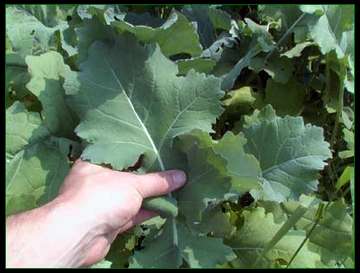
Well-fertilized stands of rape can produce 1½ to 4 tons of forage/acre over a short grazing season from October-January. As far as management, it is important to plant rape early from August in North through September in the South. Later planted rape may not fully mature before cold weather. Deer commonly hit rape hard in late season when frosts raise the sugar content of the leaves, removing all leafy forage quickly. For this reason, I recommend strip planting rape next door to clover mixes especially in fields one acre or larger. Mixing rape with clovers, chicory, and/or wheat is another option but it’s tricky. Be very careful on rates, not broadcasting more than one lb./acre rape (shade factor), 10-lbs./acre crimson clover, 10-lbs./acre arrowleaf clover and 50-lbs/acre wheat. Because of diseases, do not plant rape on the same ground for more than two straight years!
Turnipsspecies profileTurnips are drought tolerant cool weather crops providing roots, stem, and leaf growth for grazing 90 days or more after seeding. Top leafy growth generally will survive temperatures between 15-20 degrees while bulbs will stand temperatures about 5 degrees cooler. Depending upon variety and fertility, turnips yield 1.5 to 5 tons/acre of dry matter including the bulb. The mature tops have 17-24% crude protein while roots commonly contain 12-15% protein.

In the Deep South, plant as late as October to accomplish the goal of vigorous root growth during periods of low temperatures. The leaves maintain their nutritional quality even after repeated exposure to frost. Turnips grow best in loamy, fertile and slightly acid soil (pH 6.0-6.5). Turnip seed is small and should be seeded into a fine, firm weed-free seedbed. The seed should never be covered more than ¼-inch deep.
Timing of the planting to coincide with first frosts occurring 90 days after planting goes a long way toward managing the deer grazing pressure and maximum production. There are many varieties of turnips including those selected for forage or root. To avoid serious diseases, plant no more than two successive years.
Oatsspecies profileOats may be the best of five annual small grains grown for deer in the U.S. Oats average about 3-feet tall and have mainly been grown for grain, pasture, hay, or silage. Oats can produce 1-4 tons per acre of high quality (10-20% protein), cool season forage that is highly digestible (60%). In palatability tests using horses, oats were consistently selected above ryegrass, rye, wheat or triticale.

Oats are sensitive to cold, however, so the South is one of the main area where oats should be planted in the fall. Oats tolerate heavy grazing but are not tolerant of poor drainage or drought. Oats have excellent seedling vigor but are sensitive to low pH and fertility. I recommend mixing oats with legumes. This saves on nitrogen (N) bills, and adds to the quality and longevity of the planting. My favorite oat mixes are oats (50 lbs./acre), crimson clover (10 lbs./acre) and arrowleaf clover (10 lbs./acre) in the South. Best time to plant is September or October.
Rye species profileRye is grown in every state in the United States, often when conditions are unfavorable for wheat. Rye is more cold tolerant than oats or wheat and tolerates low fertility and acid soil more than any other small grain. Rye can be grown in a wider range of environmental conditions than any other small grain. Do not confuse cereal rye with annual or perennial ryegrass, they are totally different plants!

Deer eat the tender nutritious (12-25% protein) foliage in fall, winter and early spring. Of the three small grains, however, most deer managers would rank rye as third in preference to oats and wheat. This varies by region, weather soil fertility and other factors.
Rye is usually planted in September in the North and October in the South. If planted alone, 90 to 120 lbs./acre is recommended. Planted in mixtures, no more than 50 lbs./acre should be broadcast. I would never consider planting rye alone for deer with one exception. When it is too late or too cold to plant anything else, rye serves as an ideal late fall/early spring season cover crop that will germinate and grow in colder, poorer, more acidic soil than any other plant. Otherwise, mix rye with one or more legumes such as arrowleaf clover (10 lbs./acre), crimson clover (10 lbs./acre), Austrian winter peas (25 lb./acre). Like all other small grains, rye will achieve greatest forage and seed production when soil pH is above 6.0. A complete fertilizer applied according to soil test at planting (example: 300 lbs./acre 19-19-19) is highly recommended whether planted alone or in a mix. Varieties with high forage production can produce about 3 tons/acre (6,000 lbs.) dry weight forage.
Wheat species profileGrown practically everywhere in the United States, wheat is one of the most valuable wildlife plants in the entire country. Deer eat the tender nutritious (15-20% protein) foliage in fall, winter and spring as well as the mature seed when available in late spring and summer. Wheat is more cold tolerant than oats but not as cold tolerant or acid tolerant as rye. Of the three small grains, most experts would rank wheat as second in preference or palatability to oats.

Wheat is usually planted in September in the North or October in the South. If planted alone 90 to 120 lbs./acre is recommended. Planted in mixtures, no more than 60 lbs./acre (one bushel/acre) should be broadcast. Personally, I would never really consider planting wheat alone for deer. It is better to mix wheat with one or more legumes such as arrowleaf clover (10 lbs./acre), crimson clover (10 lbs./acre), Austrian winter peas (25 lb./acre). Besides adding palatability to the mix, the legumes make perfect companion plants for the wheat by fixing nitrogen in the soil (which is used by wheat). On the flip side, the wheat acts as a nurse crop for the legumes for the first month after planting by producing vigorous early growth which takes the brunt of the early deer grazing pressure while the legumes develop a root system.
Like other small grains, wheat will achieve greatest forage production when soil is limed to raise pH above 6.0. A complete fertilizer applied according to soil test at planting (example: 300 lbs./acre 19-19-19) is highly recommended whether planted alone or in a mix. Disease-resistant wheat varieties with high forage production can produce about 3 tons/acre (6,000 lbs.) forage if best management practices are followed.
Arrowleaf Cloverspecies profileArrowleaf clover is a reseeding winter annual legume with good drought tolerance and rapid growth following rain. Arrowleaf forage quality and digestible dry matter content are very high (80%). Its greatest limitation is its high susceptibility to viruses and fungi.
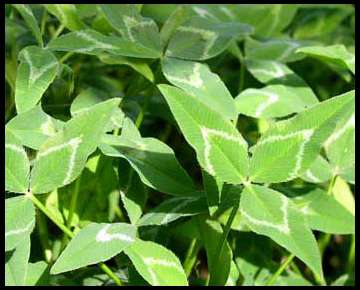
Leaves are non-hairy and arrowhead-shaped 1½ to 2½-inches long with pronounced veins. Leaf marking ranges from none to a large white, V-shaped mark. Flowering and seed production occur over a long period. Stems branch and curve upward to a height of 2 to 5 feet. The smooth, thick, hollow stems are often purple, becoming hard near maturity.
Arrowleaf is widely grown in the South but freeze-outs can occur below 10 degrees. The plant is suited to a wide range of soil conditions from well to moderately drained.
For establishment, prepare a smooth, clean seedbed. Cover seed no deeper than ¼ inch deep. In the South, plant arrowleaf in September or October. Inoculation with bacteria (strain “O”) is essential in soils where arrowleaf has not been grown. As with other clovers, don’t plant arrowleaf in a pure stand as long as conservative companion seeding rates are used. Mixes also guard against crop failures (freeze-outs, virus or fungi) with back-up plants.
Crimson Cloverspecies profileCrimson clover may be the most popular annual clover planted for deer in the entire U.S. It is an important and colorful winter annual legume where winters are mild. Crimson plants have dark green leaves and grow to a height of 1-3 feet with brilliant crimson flowers with long heads maturing from top to bottom. Seed is rounded, yellow and about 3 times larger than other clovers.

Although crimson is acid tolerant, (pH range of 5.5-6.4), it will still require liming at many sites throughout the country. Crimson should be inoculated at planting. Planting on a firm, well-prepared seedbed by broadcasting, cultipacking or drilling enhances rapid fall growth. Seed should be covered no more than ¼-inch deep. Planting dates are September and October. It will not do well in extreme heat or cold.
Phosphate and potash are required fertilizer elements, and nitrogen is needed in total production when crimson is grown with grains. Consequently, fertilizer at planting time may be 300 lbs./acre of 19-19-19 for mixed stands.
Crimson can be mixed with rye, wheat or oats if rates of these small grains are held below 60 lbs/acre total. Adding arrowleaf clover (10 lbs/acre) to the above mixes adds variety and longevity in the South where winter temperatures remain above 10oF.
Plant These Mixtures EarlyHere is the bottom line. If you have two acres or more, use two mixtures of at least one acre each: first would be a clover/small grain/winter pea mix and the second would be a Brassica/winter pea mix. Specifically, mix Crimson clover (10 lbs./acre), Arrowleaf clover (10 lbs./acre), Harrison oats (20 lbs./acre), Wintergrazer 70 rye (20 lbs./acre), wheat (20 lbs./acre) and Austrian winter pea (20 lbs./acre) for mix #1. In the North, use 10 lbs./acre of Red clover instead of the crimson. You may lose the arrowleaf and oats to freeze-out, but they would have done their job before that. For the second plot, mix Trophy Radishes™ (5 lbs./acre), Forage rape (2 lbs./acre), turnips (2 lbs./acre) and Austrian winter peas (25 lbs./acre). The best scenario would be to have these sitting side by side in one big field for double the attraction in cold weather. Another alternative is adding 5 lbs./acre Trophy Radishes›™ to Pennington’s Rackmaster Deluxe Fall Mix or Buckmaster’s Feeding Frenzy. These are virtually the same as mix #1 above.
If you have only one acre or less, use mix #1 or the commercial alternative above and add 5 lbs./acre of Trophy Radishes™ for extra forage and attraction. In any case, DO NOT SKIMP ON FERTILIZER! Fertilizer is what produces the highest protein and carbohydrate levels in all plants and definitely makes them taste better to hungry deer. It is worth repeating what was in many of the profiles above. Apply 300 lbs./acre of 19-19-19 or whatever your soil test recommends for better growth and attraction. Even if your bucks are not thinking of food and are off their consumption during the rut, your does will enjoy the extra forage quality and quantity produced by these designer cold weather rut plots that are still productive in late season. Anchor those does on your plots on your property and the bucks will come!
|
